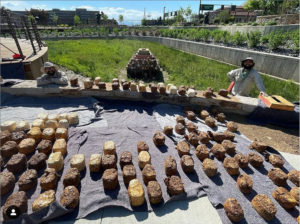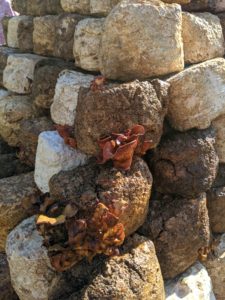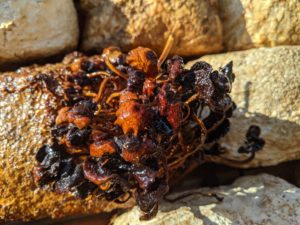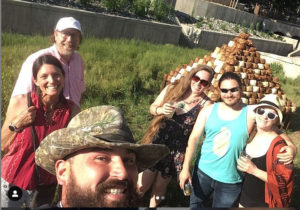A unique pyramidal sculpture composed entirely of mushrooms is now on display at the Denver Museum of Art’s Museum of Outdoor Arts’ Marjorie Sculpture Park, next to Fiddler’s Green Amphitheater located at:
6331 S Fiddlers Green Cir, Greenwood Village, CO 80111.
The brainchild of brothers Ricardo Alberto Ramirez Garcia-Rojas and Marcelo Alejando Ramirez Garcia-Rojas this piece is a temporary installation and must be seen while it lasts.

ARTISTS STATEMENT:
NANACATL
Across time, the human species has built pyramid structures to illustrate power, social status, spirituality, and knowledge. Today, we are using the pyramid to bring light and focus to the opportunities and resources that the fungal kingdom provides to us humans as a species. By teaming up with the fungal kingdom, we can achieve food production, biocomposite manufacturing, ecological pesticides, grow clothing, catalyze bioremediation, replace polystyrene products, develop antibiotics, and much more as we continue to learn together and work together across fields to build a more sustainable future for us all.
NANACATL (Hongo; Fungus) is an ephemeral, biodegradable sculpture made of fungal mycelium bricks.
NANACATL is pronounced “NAH-NAH-CAH-TL” (the final -TL is pronounced like the English -ttle in “little” or “rattle”) The definition of NANACATL is Hongo or Fungus. The language is Nahuatl, a native tongue spoken throughout Mexico, most notably by the Azetc and Mexica peoples, whose pyramid architecture inspired the structure of NANACTL.
NANACATL is both sculpture and experimentation.
NANACATL is composed of 311 individual fungal mycelium bricks, across 4 different species: Blue Oyster Mushroom (Pleurotus ostreatus var. columinus), Pink Oyster Mushroom (Pleurotus djamor), Chestnut Mushroom (Pholiota adiposa), and Lion’s Mane Mushroom (Hericium erinaceus).
The mycelium bricks for NANACATL began as spent mushroom blocks graciously donated by Ramiro Villareal of The Mushroom Source, based out of Mission, TX. His bricks ultimately became the cornerstone of this project.
 Inspired by mycologists like Jeff Ravage, from the Coalition for the Upper South Platte, Paul Stamets of Fungi Perfecti, Phil Ross of MycoWorks, and applying the protocols Ricardo was learning while conducting his MS Thesis experiments at Dr. Daniel Flores’ fungal biocontrol lab at USDA APHIS, we had initially set up our own lab to grow our sculpture. We were confidently producing hundreds of grain spawn mason jars of Pleurotus pulmonarious, which we were using to inoculate 30 gallon tubs of hay that we had treated with a hydrated lime (calcium hydroxide) bath. We had about thirty-five of the ninety-one original 30 gallon bricks growing strong, so we decided that we could leave our grow space to go work on the Museum of Outdoor Arts’ Living Wall at Fiddler’s Green Amphitheater. We came back 3 weeks later to find that ALL of our 30 gallon bricks were severely infected with what looked like a Pennecilin mold. Unfortunately, we had neither planned for a mass infection in our timeline nor in our budget. We came to the realization that we needed to adopt an entirely different approach to finish our project.
Inspired by mycologists like Jeff Ravage, from the Coalition for the Upper South Platte, Paul Stamets of Fungi Perfecti, Phil Ross of MycoWorks, and applying the protocols Ricardo was learning while conducting his MS Thesis experiments at Dr. Daniel Flores’ fungal biocontrol lab at USDA APHIS, we had initially set up our own lab to grow our sculpture. We were confidently producing hundreds of grain spawn mason jars of Pleurotus pulmonarious, which we were using to inoculate 30 gallon tubs of hay that we had treated with a hydrated lime (calcium hydroxide) bath. We had about thirty-five of the ninety-one original 30 gallon bricks growing strong, so we decided that we could leave our grow space to go work on the Museum of Outdoor Arts’ Living Wall at Fiddler’s Green Amphitheater. We came back 3 weeks later to find that ALL of our 30 gallon bricks were severely infected with what looked like a Pennecilin mold. Unfortunately, we had neither planned for a mass infection in our timeline nor in our budget. We came to the realization that we needed to adopt an entirely different approach to finish our project.
So, like the mycelium, we adapted, and reached out to other mycelium to create stronger bonds for further growth. We knew that to find the mycelium, we needed to find the nearest mushroom growers. Our friend, Diego Ramos of Diego’s Farm to Table Food Truck put us in contact with his gourmet mushroom source, Ramiro Villareal of One Up Mushroom Products. Like most mushroom growers, Ramiro was left with bricks and bricks of live mycelium after his mushroom harvests. Being a small-scale grower however, his focus was on the mushrooms, so the mycelium left over from harvest was an afterthought, which ultimately ended up in the trash. When we met him, he was so happy to give us his spent bricks. He said that he knew that they were useful, but did not have the time nor the space to try to do anything with them.
The following is our process for this work:
- Transported from Ramiro’s grow operation to our space in either plastic bags or plastic totes to prevent further contamination.
- Cleaned grow bags containing the mycelium brick using a 10% chlorine solution or 70% alcohol.
- Cut and peeled bags off of mycelium carefully to not alter the shape, cleaned off any visible mold spores from brick using 70% alcohol and 3% hydrogen peroxide.
- Placed bricks in high humidity chambers (in our case, we had a 30 gallon plastic tote with moist sterilized denim on the bottom). Bricks were placed on their own plastic covering.
- Allowed bricks to mycose on the surface for about 1 week in order to strengthen the bond of the mycelium.
- Took bricks out to dry in our garage (which with our climate, remained about 85-100 F, 60% humidity) for about 1 week. Here is where we saw the additional flushes of mushrooms which now adorn the pyramid.
- Placed bricks in oven at 200F for 2 hours to kill the organism and dry any attached mushrooms.
- Finished the bricks with either shellac, lacquer, or polyurethane.

Some of the things we learned through our process are as follow:
From the species that we used, Pleurotus ostreatus produced the hardiest, most structurally sound and cohesive bricks, it also mycosed around the edges of the bricks the best, holding the substrate together.
Lacquer produced a nice white finish on the fully mycosed Pleurotus ostreatus bricks, but it was highly flammable in our burn tests, so we decided to stop finishing additional bricks with it. We constructed the base of the pyramid with fire-retardant wood, since we did include these bricks in our sculpture. We also noticed the lacquer chipping off the surface of the mycobrick, so we do not recommend using it to weatherproof bricks.
Shellac also did not produce promising weathering results, we noticed that it started to dissolve off of the brick when we left them submerged in water.
However, polyurethane did perform well as a weathering agent. The main reason being that it helped hold the dry bricks together like an adhesive, especially with the brown Chestnut mushroom bricks which were very brittle after drying. We also found that polyurethane chemically is a complex polymer made of Carbon, Hydrogen, Oxygen, and Nitrogen, which a fungus like Pleurotus, used in oil spill remediations, could in theory break down over time.
To assemble NANACATL, we custom sized a wooden pyramid base for our bricks, and we attached them from inside the pyramid using 4” screws, or to each other using straightened out landscaping pins.
Screws worked especially well for adhering bricks to wood. Our fun screw test that we did with these bricks consisted of screwing a finished brick onto a piece of wooden 2×4, clearing the backyard, and swinging that makeshift mycelium axe around like we were re-enacting a scene from Gladiator starring Russel Crowe. We were very happy to see that the brick stayed fastened onto the 2×4 after our whole battle scene had come to a peaceful end.
The main lesson that we learned from all of this informal experimentation is finding where we fit best in the mycological community. We learned to leave the growing to growers and to instead team up with them. Collectively we can do more, go further, and ultimately, as in our case, process their waste into experimental and sustainable media for art and manufacturing.
NANACATL is a beacon, not only for the potential that naturally derived fungal materials have for sustainable construction and manufacturing, but also for the multilevel interconnectivity and symbiosis these organisms play in our human lives and existence as a species. This project aims to inspire future generations of builders and mycologists alike to employ the power of fungi in molding the trajectory of our Earth.
NANACATL is housed at the Museum of Outdoor Arts’ Marjorie Sculpture Park, next to Fiddler’s Green Amphitheater located 6331 S Fiddlers Green Cir, Greenwood Village, CO 80111.
NANACTL will be on display temporarily, from 12 June 2021, until the mycelium bricks biodegrade – which could be anywhere from a couple of weeks to a couple of months. We will all find out together how long a weather-treated mycelium sculpture like this lasts when exposed to the Colorado elements.
NANACATL was built by brothers Ricardo Alberto Ramirez Garcia-Rojas and Marcelo Alejando Ramirez Garcia-Rojas.


Ricardo Alberto Ramirez Garcia-Rojas is a graduate of Harvard University where he studied Psychology and Filmmaking. He holds a Masters Degree in Agriculture, Environment, and Sustainability Sciences from the University of Texas Rio Grande Valley. During his time there, he conducted research with the United States Department of Agriculture, Animal and Plant Health Inspection Service employing entomopathogenic fungi as a biological control for mosquitoes and the diseases they vector.
Marcelo Alejandro Ramirez Garcia-Rojas is a graduate of the University of Denver where he studied International Development and Studio Art. He has been involved with the Museum of Outdoor Arts (MOA) since 2017, where he began his career in the Arts as an intern in the MOA Design and Build Program. Marcelo has exhibited works in Colorado, Texas, and Cuba.
We are currently working and experimenting with mycelium sculptures, buoyant mycelium for fishing floats, and mold proof mycelium for insulation. If you would like to learn more about our project, or you have any pointers, ideas, or protocol suggestions to help us move forward in our experimentation of water and weatherproofing mycelium for outdoor applications you can reach us via email at Ricardo.RamirezGarciaRojas@gmail.com, marcelorgr112@gmail.com, or on our Instagram @el_templo_del_nanacatl.
Thank you so much for everything, we hope to hear from you, and, we hope you enjoy NANACATL while it is on display.
